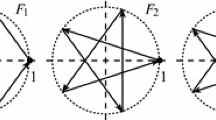Abstract
A class of polygons termedunimodal is introduced. LetP = P1,p 2,...,p n be a simplen-vertex polygon. Given a fixed vertex or edge, several definitions of the distance between the fixed vertex or edge and any other vertex or edge are considered. For a fixed vertex (edge), a distance measure defines a distance function as the remaining vertices (edges) are traversed in order. If for every vertex (edge) ofP a specified distance function is unimodal thenP is a unimodal polygon in the corresponding sense. Relationships between unimodal polygons, in several senses, andconvex polygons are established. Several properties are derived for unimodal polygons when the distance measure is the euclidean distance between vertices of the polygons. These properties lead to very simple 0(n) algorithms for solving a variety of problems that occur in computational geometry and pattern recognition. Furthermore, these algorithms establish that convexity is not the key factor in obtaining linear-time-complexity for solving these problems. The paper closes with several open questions in this area.
Similar content being viewed by others
References
C. Arcelli, and S. Levialdi, Concavity point detection by iterative arrays,IEEE Trans. on Systems, Man, and Cybernetics,SMC-1, (4) 394–396 (October 1971).
T. Pavlidis, Representation of figures by labelled graphs,Pattern Recognition, Vol.4:5–17 (1972).
B. Schacter, Decomposition of polygons into convex sets,IEEE Trans. on Computers,C-27, 1078–1082 (1978).
G. T. Toussaint, The convex hull as a tool in pattern recognition,Proc. AFOSR Workshop in Communication Theory and Applications, Provincetown, Massachusetts, pp. 43–46 (September 1978).
B. M. Chazelle, Computational geometry and convexity, Tech. Rept. No. CMU-CS-80-150, Department of Computer Science, Carnegie-Mellon University, (July 1980).
I. M. Yaglom, and V. G. Boltyanskii,Convex Figures, (translated by P. J. Kelly and L. F. Walton) Holt, Rinehart & Winston, (1961).
V. G. Boltyanskii, and I. T. Gohberg,The Decomposition of Figures into Smaller Parts, (translated by H. Christoffers and T. P. Branson) The University of Chicago Press, (1980).
R. V. Benson,Euclidean Geometry and Convexity, McGraw-Hill, (1966).
V. L. Klee, (ed.),Convexity, Proc. of Symposia in Pure Mathematics, Vol. VII, American Mathematical Society, (1963).
W. E. Snyder, and D. A. Tang, Finding the extrema of a region,IEEE Trans. Pattern Analysis and Machine Intelligence,PAMI-2:266–269 (May 1980).
D. P. Dobkin and L. Snyder, On a general method for maximizing and minimizing among certain geometric problems,Proc. 20th Annual Symposium on Foundations of Computer Science, San Juan, Puerto Rico, pp. 9–17 (October 1979).
B. K. Bhattacharya and G. T. Toussaint, A counterexample to a diameter algorithm for convex polygons,IEEE Transactions on Pattern Analysis and Machine Intelligence,PAMI-4:306–309 (May 1982).
D. Avis, G. T. Toussaint, and B. K. Bhattacharya, On the multimodality of distances in convex polygons,Computers ans Mathematics with Applications,8 (2) 153–156 (1982).
G. T. Toussaint, Pattern recognition and geometrical complexity,Proc. Fifth International Conf. on Pattern Recognition, Miami Beach, pp. 1324–1347 (December 1980).
G. T. Toussaint, Computational geometric problems in pattern recognition,Pattern Recognition Theory and Applications, J. Kittler, (ed.), NATO-ASI, Oxford University, (April 1981).
L. K. Jones, personal communication.
C. Lantuejoul, personal communication.
G. T. Toussaint, The relative neighborhood graph of a finite planar set,Pattern Recognition,12:261–268 (1980).
G. T. Toussaint, The symmetric all-furthest-neighbor problem,Computers and Mathematics with Applications,9 (6):747–754 (1983).
L. Moser, On the different distances determined by n points,Amer. Math. Monthly,59:85–91 (1952).
E. Altman, On a problem of P. Erdös,Amer. Math. Monthly,70:148–157 (1963).
M. I. Shamos, Problems in Computational Geometry, Carnegie-Mellon University, (1977).
G. T. Toussaint and B. K. Bhattacharya, On geometric algorithms that use the furthest-point Voronoi diagram, Tech. Rept. No. SOCS-81.3, School of Computer Science, McGill University, (January 1981).
M. I. Shamos and D. Hoey, Closest-point problems,Sixteenth Annual IEEE Symp. on Foundations of Computer Science, pp. 151–162 (October 1975).
D. T. Lee, and F. P. Preparata, The all-nearest-neighbor problem for convex polygons,Information Processing Letters,7:189–192 (June 1978).
K. Supowit, The relative neighborhood graph with an application to minimum spanning trees, Tech. Rept., Dept. of Computer Science, University of Illinois, Urbana, (August 1980).
C. C. Yang and D. T. Lee, A note on the all-nearest-neighbor problem for convex polygons,Information Processing Letters,8:193–194 (April 1979).
A. Fournier, and Z. Kedem, Comments on the all-nearest-neighbor problem for convex polygons,Information Processing Letters,9:105–107 (1979).
S. Olariu, personal communication.
N. Tsikopoulos, personal communication.
A. Aggarwal, and R. C. Melville, Fast computation of the modality of polygons, Tech. Rept., The Johns Hopkins University, (1983).
F. P. Preparata, and K. J. Supowit, Testing a simple polygon for monotonicity,Information Processing Letters, (1982).
Author information
Authors and Affiliations
Rights and permissions
About this article
Cite this article
Toussaint, G.T. Complexity, convexity, and unimodality. International Journal of Computer and Information Sciences 13, 197–217 (1984). https://doi.org/10.1007/BF00979872
Received:
Revised:
Issue Date:
DOI: https://doi.org/10.1007/BF00979872




